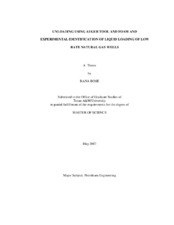| dc.description.abstract | Low-pressure, low-producing natural gas wells commonly encounter liquid loading
during production. Because of the decline in the reservoir pressure and the flow
capacity, wells can fall below terminal velocity. Identifying and predicting the onset
of liquid loading allows the operators to plan and prepare for combating the liquid
loading hence saving valuable reserves and downtime. The present industrial
applications of artificial lift, wellhead pressure reduction by compressor installation
at the wellheads and reduction in tubing size are costly and often intermittent. The
thesis examines the above aspects to generate a workflow for identifying and
predicting the liquid loading conclusively and also assessing the application of
Auger Tool and foam combination towards achieving a cost effective and more
efficient solution for liquid unloading.
In chapters I-IV, I describe the process of using production surveillance software of
Halliburton Digital Consulting Services, named DSS (Dynamic Surveillance
Software), to create a workflow of identifying the liquid loaded wells based on well
data on daily basis for field personnel and engineers. This workflow also decides the most cost effective solution to handle it. Moreover, it can perform decline
analysis to predict the conditions of liquid loading.
In chapters V-VIII of the thesis, I describe the effort of handling the problem of
liquid loading in a cost effective manner by introduction of an inexpensive Auger
Tool in the bottomhole assembly and using WhiteMax surfactant soapstick from
J&J Solutions. Four different combinations of well completion and fluid were tested
for performance in respect to liquid hold up, pressure loss in the tubing, unloading
efficiency and critical flow requirement. The test facilities and instruments, along
with the operational methods, are discussed in chapter VI.
Except for the reduction of the operational envelope with the inclusion of Auger
Tool, the performance improved with the insertion of Auger Tool. The best
combination of Auger and foam system could be a result of flow modification by the
Auger Tool caused by reduced pressure loss and increase in drag coefficient and
also by reduced density and surface tension of foam. | en |


